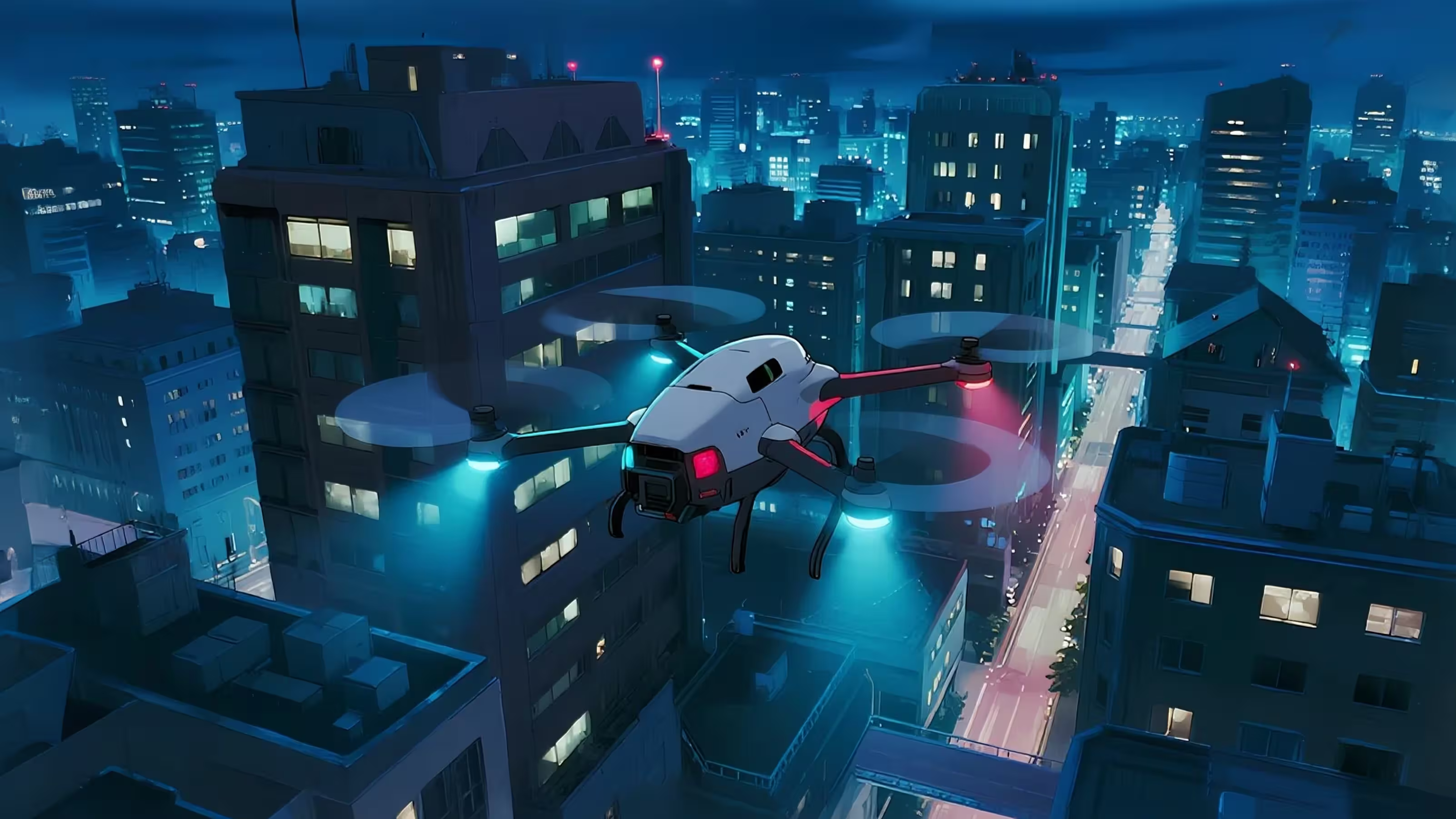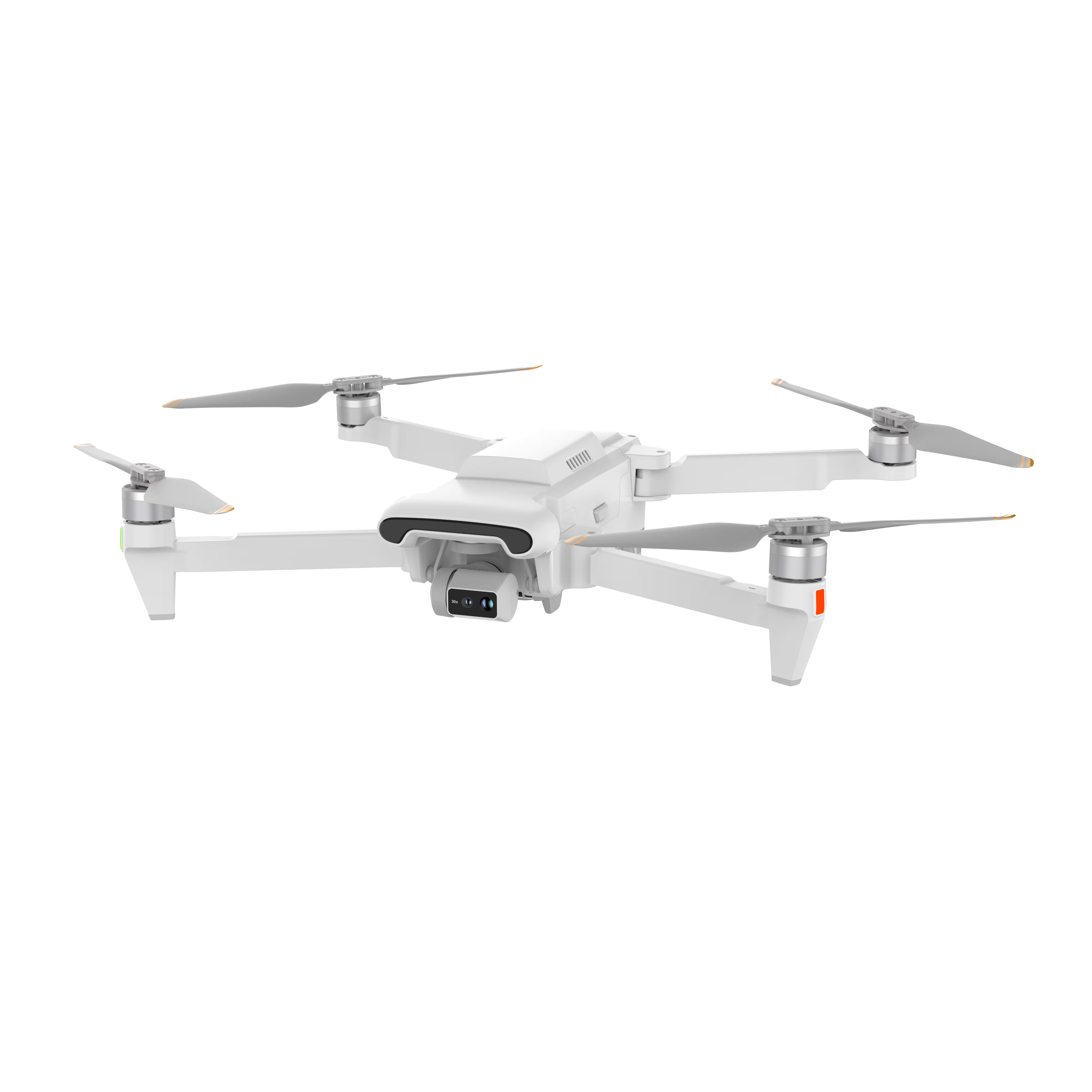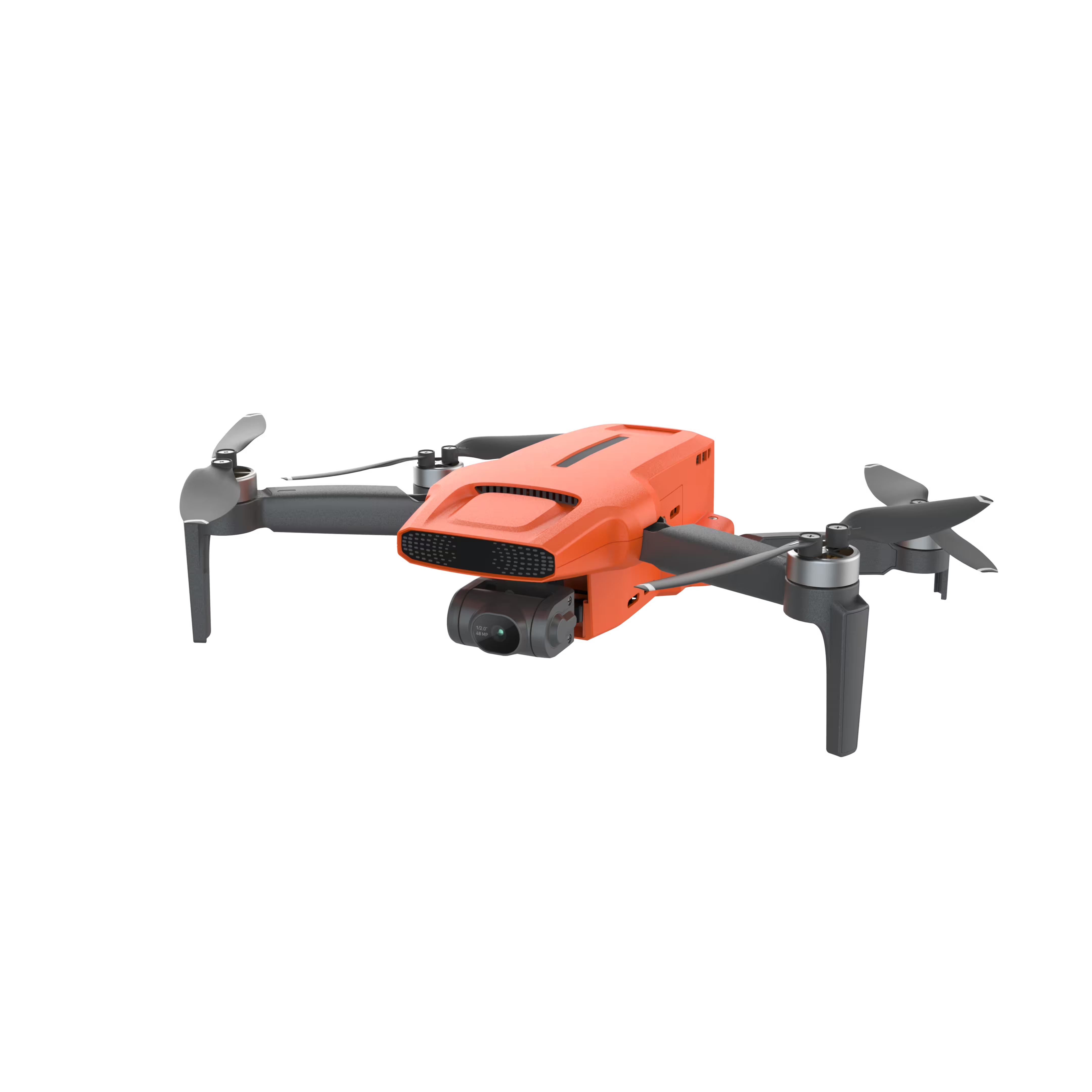Low-light/Night Environment Shooting
Aerial photography drone solutions for low-light/night environment shooting integrate AI Super Night Mode, high-resolution sensors with 4K/60fps video, and 3-axis mechanical stabilization gimbals to address excessive noise, insufficient dynamic range, and blurred long-exposure images in dimly lit environments.
Painpoints
- – Excessive noise in low-light environments: Poor image clarity and blurred details in dimly lit environments (e.g., night cityscapes, starry sky shooting).
- – Insufficient dynamic range: Overexposed highlights and dead-black shadows fail to retain both bright and dark details, affecting night scene layering.
- – Poor stability in long exposure: Low-light environments require extended exposure time; manual control easily causes image shaking, resulting in blurred images.
Advantages
- AI Super Night Mode (e.g., Mini 3, X8 Tele Max): Algorithm optimization improves image quality in low-light environments, suppresses noise, and presents pure and clear night images.
- 4K/60fps video + high-resolution sensor (e.g., X8 Tele Max 48MP, Mini 3 4K/60fps): High resolution enhances detail capture capability; 4K video smoothly records night dynamic changes, enriching light-dark layers.
- 3-axis mechanical stabilization gimbal (e.g., Mini 3): Physical anti-shake reduces long-exposure jitter, ensuring clear and sharp images in low-light environments without relying on post-processing anti-shake.
Solution

AI-Powered Low-Light Noise Reduction & Clarity Enhancement
Enhances image quality in low-light/night environment shooting by minimizing noise and improving clarity, ideal for capturing pure, detailed night scenes.
- AI Super Night Mode algorithm suppresses noise in dimly lit environments (e.g., night cityscapes, starry sky shooting).
- Optimizes image clarity to preserve fine details (e.g., mountain outlines, architectural textures) that would otherwise appear blurred in low light.
- Delivers pure, clear night images without excessive grain, ensuring vivid results in challenging lighting conditions for low-light/night environment shooting.
Drone Platform

X8 Tele Max
Dual-Camera Flagship Drone - 30X Hybrid Zoom | 4K 60fps | 20KM Transmission | 47min Flight Time Read More
Learn More
Mini 3
Ultra-Portable 4K Drone - 245g Lightweight | 48MP Photos | 9km HD Transmission | AI Night Vision | 32min Flight Time Read More
Learn MorePayload And Software
Revolutionizing Detail and Purity in Low-Light/Night Environment Shooting
In low-light/night environment shooting, capturing clear, detailed images has long been a challenge—dimly lit scenes often suffer from excessive noise, blurred textures, and grainy footage that obscure the beauty of night landscapes, cityscapes, or starry skies. MMC’s AI-Powered Low-Light Noise Reduction & Clarity Enhancement solution directly addresses these pain points, leveraging advanced AI algorithms to transform low-light/night environment shooting from a frustrating struggle into a seamless, high-quality experience.
By combining noise suppression, clarity optimization, and pure image delivery, this solution ensures that even the darkest scenes in low-light/night environment shooting retain stunning detail and vibrancy, making it indispensable for enthusiasts and casual users alike.
At the core of this solution is the AI Super Night Mode algorithm, a game-changer for reducing noise in low-light/night environment shooting. In dimly lit environments—whether filming a twinkling night cityscape, a quiet suburban street lit by streetlights, or a starry sky—traditional drones often produce grainy, speckled footage as sensors amplify light signals, introducing unwanted noise. MMC’s AI Super Night Mode counteracts this by intelligently analyzing each frame, distinguishing between genuine details (e.g., distant building windows, tree branches, or individual stars) and noise artifacts.
The algorithm then suppresses noise without blurring critical textures, resulting in cleaner, smoother images. For example, when shooting a night cityscape, the AI minimizes the “snowy” grain that typically plagues dark sky areas, while preserving the sharp edges of skyscrapers and the warm glow of streetlights. In starry sky shooting, it reduces sensor noise to keep star points crisp and distinct, avoiding the blurry “clouds” of noise that can obscure constellations. This targeted noise reduction is transformative for low-light/night environment shooting, turning once-unusable footage into professional-grade content.
Equally vital is the solution’s ability to optimize image clarity and preserve fine details that would otherwise vanish in low-light/night environment shooting. Low light often washes out textures, leaving scenes looking flat or blurred—mountain outlines become indistinct, architectural textures (like brickwork or roof tiles) blend into smudges, and distant subjects lose definition. MMC’s AI algorithm combats this by enhancing edge detection and sharpening critical details without over-processing.
For instance, when filming a moonlit mountain range, the AI emphasizes the jagged edges of peaks and the rough texture of rock faces, ensuring they stand out against the dark sky. In urban low-light/night environment shooting, it sharpens the lines of bridges, the intricate patterns of historical buildings, or even the expressions on people’s faces in dimly lit outdoor gatherings. This clarity optimization ensures that low-light/night environment shooting captures not just the “gist” of a scene, but the nuanced details that make it memorable—whether it’s the weathered bark of a tree in a night forest or the intricate design of a city monument lit by spotlights.
Rounding out the solution is its commitment to delivering pure, clear night images without excessive grain, a hallmark of MMC’s approach to low-light/night environment shooting. Excessive post-processing or aggressive noise reduction can often leave images looking artificial or “plastic,” stripping them of their natural feel. MMC’s AI strikes a balance: it reduces noise while preserving the organic quality of light and shadow in night scenes.
For example, in a candlelit outdoor dinner shoot, the algorithm softens noise in the dim background without washing out the warm, flickering glow of the candles or the subtle gradients of shadow on faces. In a quiet lakeside night scene, it keeps water reflections smooth and ripple-free, avoiding the grain that would disrupt the calm, mirror-like effect. This purity ensures that low-light/night environment shooting feels authentic—capturing the mood of the moment, whether serene, lively, or dramatic—without compromising on technical quality.
In summary, MMC’s AI-Powered Low-Light Noise Reduction & Clarity Enhancement solution redefines what’s possible in low-light/night environment shooting. By harnessing AI Super Night Mode to suppress noise, optimizing clarity to preserve fine details, and delivering pure, grain-free images, it empowers users to capture the beauty of the night with confidence.
Whether shooting starry skies, bustling night markets, or quiet moonlit landscapes, this solution ensures that low-light/night environment shooting is no longer a battle against darkness—but an opportunity to reveal the hidden details and vibrant moods that only the night can offer. For anyone passionate about low-light/night environment shooting, this technology transforms challenges into opportunities, turning every dark scene into a canvas for stunning, detailed storytelling.

High-Resolution Dynamic Night Capture with Rich Light-Dark Layers
Captures sharp, detailed night footage with balanced light-dark layers, enhancing dynamic range for low-light/night environment shooting.
- Equipped with high-resolution sensors (e.g., X8 Tele Max 48MP) to boost detail capture capability in low light, ensuring crisp textures in night scenes.
- Supports 4K/60fps video (e.g., Mini 3) to smoothly record dynamic night changes (e.g., moving traffic, twinkling city lights), avoiding choppy footage.
- Enriches light-dark layers by balancing highlights and shadows, preventing overexposed bright areas or dead-black dark regions, and enhancing the depth of night scenes in low-light/night environment shooting.
Drone Platform

X8 Tele Max
Dual-Camera Flagship Drone - 30X Hybrid Zoom | 4K 60fps | 20KM Transmission | 47min Flight Time Read More
Learn More
Mini 3
Ultra-Portable 4K Drone - 245g Lightweight | 48MP Photos | 9km HD Transmission | AI Night Vision | 32min Flight Time Read More
Learn MorePayload And Software
Enhancing Light-Dark Layers for Stunning Low-Light/Night Environment Shooting
In low-light/night environment shooting, capturing dynamic scenes with both sharp detail and balanced light-dark layers has long been a challenge. Dim conditions often wash out textures, fast-moving subjects (such as traffic or twinkling city lights) may appear choppy, and extreme contrasts—overexposed highlights (e.g., bright streetlights) and dead-black shadows (e.g., dark alleyways)—can flatten the depth of night scenes.
MMC’s High-Resolution Dynamic Night Capture with Rich Light-Dark Layers solution directly addresses these pain points, transforming low-light/night environment shooting from a frustrating struggle into a seamless, high-quality experience. By integrating high-resolution sensors, 4K/60fps video capabilities, and intelligent light-dark balance optimization, this solution ensures low-light/night environment shooting delivers sharp, fluid, and deeply layered footage, making even the darkest scenes vivid and immersive.
At the core of this solution is the high-resolution sensor, a cornerstone for preserving detail in low-light/night environment shooting. In dimly lit scenarios—whether filming a starry urban skyline, a quiet moonlit mountain range, or a bustling night market—traditional low-resolution sensors often fail to capture fine textures, leaving night scenes looking soft or featureless. MMC consumer drones, such as the X8 Tele Max equipped with a 48MP sensor, overcome this limitation by packing millions of pixels into each frame, enabling the capture of minute details even in low light.
For example, in low-light/night environment shooting of a historic city district, the 48MP sensor distinguishes individual bricks on ancient buildings, the intricate lattice of streetlamp designs, and the weathered edges of stone pavements—details that would blur into indistinct smudges on lower-resolution devices. In natural settings like a night forest, it preserves the rough texture of tree bark, the delicate veins of leaves, and the subtle ripples of a dark lake’s surface. This high resolution ensures low-light/night environment shooting is not just about “documenting the scene,” but about revealing the stories hidden in its details, making every night image feel crisp and lifelike.
Equally critical is the support for 4K/60fps video, a game-changer for capturing dynamic movement in low-light/night environment shooting. Night scenes are rarely static: cars streak through city streets, festival lights flicker, crowds flow, and waves lap at moonlit shores. Low frame rates (e.g., 30fps) can turn this motion into choppy, blurred footage, robbing low-light/night environment shooting of its energy. MMC drones, including the Mini 3, tackle this with 4K/60fps video, doubling the frame rate to ensure smooth, lifelike motion.
For instance, when filming a busy night intersection, 60fps captures the fluid trail of car headlights as they weave through traffic, avoiding the “stuttering” effect of lower frame rates.
In a fireworks display, it preserves the crisp burst of each spark and the graceful arc of light across the dark sky. Even subtle movements—like the flutter of a flag in a night breeze or the dance of candlelight in an outdoor gathering—are rendered with clarity, making low-light/night environment shooting feel dynamic and alive. This smoothness transforms footage from “watchable” to “captivating,” ensuring the energy of night scenes is preserved in every frame.
Rounding out the solution is its ability to enrich light-dark layers by balancing highlights and shadows, a key factor in elevating the depth of low-light/night environment shooting. Night scenes are defined by contrast: bright neon signs against starry skies, glowing streetlights against dark buildings, or moonlit peaks against shadowed valleys. However, without careful balance, highlights can blow out to featureless white, and shadows can collapse into inky blackness, stripping the scene of depth. MMC’s solution addresses this by intelligently optimizing dynamic range, ensuring both bright and dark areas retain detail.
For example, in low-light/night environment shooting of a city skyline, it prevents overexposed skyscraper windows from washing out while preserving the subtle gradients of dark rooftops and the twinkle of distant lights.
In a mountainous night scene, it keeps the moonlit snow on peaks bright but not blinding, while revealing the texture of shadowed rock faces below. This balance creates a sense of three-dimensionality, making night scenes feel layered and immersive—whether it’s the glow of a lone cabin in a dark forest or the sprawling lights of a metropolis stretching to the horizon. By avoiding flat, contrast-starved footage, this feature ensures low-light/night environment shooting captures the full emotional impact of the night, from its quiet serenity to its vibrant energy.
In summary, MMC’s High-Resolution Dynamic Night Capture with Rich Light-Dark Layers solution redefines excellence in low-light/night environment shooting. By combining high-resolution sensors for unmatched detail, 4K/60fps video for smooth dynamic capture, and intelligent light-dark balance for enhanced depth, it empowers users to transform low-light/night environment shooting challenges into stunning opportunities.
Whether capturing urban nightlife, natural night landscapes, or intimate evening gatherings, this solution ensures every frame of low-light/night environment shooting is sharp, fluid, and richly layered—revealing the hidden beauty of the night world in unprecedented clarity.

Long-Exposure Anti-Shake for Sharp Low-Light Imaging
Reduces jitter during long exposures in low-light/night environment shooting, ensuring sharp, stable images without relying on post-processing.
- Integrated 3-axis mechanical stabilization gimbal provides physical anti-shake, minimizing image jitter caused by manual control during extended exposure.
- Ensures clear, sharp images in low-light conditions (e.g., long-exposure starry sky shots, night landscapes) by stabilizing the camera platform.
- Eliminates the need for post-processing anti-shake, preserving original image quality and detail in low-light/night environment shooting.
Drone Platform

X8 Tele Max
Dual-Camera Flagship Drone - 30X Hybrid Zoom | 4K 60fps | 20KM Transmission | 47min Flight Time Read More
Learn MorePayload And Software
Ensuring Sharp, Stable Imaging in Low-Light/Night Environment Shooting
In low-light/night environment shooting, long-exposure techniques are often essential to capture stunning details—whether it’s the soft glow of a moonlit landscape, the trailing lights of moving cars, or the delicate trails of stars in the night sky. However, extended exposure times amplify even the smallest camera jitter, resulting in blurred, unusable images that undermine the quality of low-light/night environment shooting. MMC’s Long-Exposure Anti-Shake for Sharp Low-Light Imaging solution directly addresses this critical pain point, leveraging advanced mechanical stabilization to deliver sharp, stable images in low-light/night environment shooting without relying on post-processing fixes.
By integrating physical anti-shake technology, stabilizing the camera platform, and eliminating the need for post-processing, this solution ensures that long-exposure shots in low-light/night environment shooting retain pristine clarity and detail, transforming challenging low-light conditions into opportunities for breathtaking photography.
At the core of this solution is the integrated 3-axis mechanical stabilization gimbal, a foundational technology for minimizing jitter in low-light/night environment shooting. In low-light conditions, cameras require longer exposure times to gather sufficient light, making them highly vulnerable to even minor movements—whether from manual control adjustments, wind gusts, or drone platform vibrations. Traditional drones often rely on digital post-processing to correct blur, but this can degrade image quality and lose fine details. MMC’s 3-axis mechanical gimbal takes a proactive approach: it physically isolates the camera from external disturbances, acting as a stabilizer to counteract pitch, roll, and yaw movements in real time.
For example, during a long-exposure night cityscape shoot, the gimbal compensates for slight hand tremors when adjusting the remote control, ensuring the camera remains steady as it captures the soft glow of streetlights and the smooth trails of car headlights. In windy low-light/night environment shooting scenarios, it minimizes platform vibration caused by gusts, preventing the blurring of distant buildings or tree outlines. This physical anti-shake is especially critical for extended exposures (e.g., 10+ seconds), where even a fraction of a degree of movement can turn a sharp image into a blurry mess. By stabilizing the camera at the source, the gimbal ensures that low-light/night environment shooting with long exposures remains crisp and distortion-free.
Beyond reducing jitter, the solution ensures clear, sharp images in low-light conditions by maintaining a stable camera platform throughout the exposure—critical for capturing intricate details in low-light/night environment shooting. Long-exposure shots in low light demand precision: starry skies require steady tracking to avoid star trails turning into smudged lines, night landscapes need sharp edges to distinguish between shadowed valleys and moonlit peaks, and architectural night shots rely on crisp lines to highlight building contours. MMC’s 3-axis gimbal excels here by locking the camera in place, creating a stable base that behaves like a tripod in the sky.
For instance, when shooting a long-exposure starry sky in low-light/night environment shooting, the gimbal keeps the camera aligned with celestial movement, preserving the pinpoint clarity of stars and the smoothness of star trails. In a night landscape featuring a mountain range, it ensures the camera doesn’t shift, capturing the rough texture of rock faces and the delicate interplay of light and shadow on slopes. Even in dynamic low-light/night environment shooting—such as capturing a bonfire’s warm glow against a dark forest—the gimbal stabilizes the camera, avoiding blurred flames or distorted smoke trails. This stability transforms low-light/night environment shooting from a risky endeavor into a reliable process, where every long-exposure shot has the potential to be sharp and striking.
Rounding out the solution is its ability to eliminate the need for post-processing anti-shake, preserving the original image quality and detail so crucial in low-light/night environment shooting. Post-processing tools for correcting blur often use algorithms to “guess” missing details or crop images, which can reduce resolution, introduce artifacts, or wash out subtle textures—especially problematic in low-light shots where detail is already scarce. MMC’s mechanical stabilization bypasses this need entirely: by capturing sharp images in-camera, it retains the full resolution, color accuracy, and fine details of the original scene.
For example, a long-exposure night portrait in low-light/night environment shooting preserves the subject’s facial expressions and the soft bokeh of background lights without the smearing or loss of sharpness that post-processing might introduce. In a low-light urban panorama, the gimbal ensures each stitch in the panorama is sharp, avoiding misalignments caused by shaky frames that would require cropping or warping in editing. This not only saves time for users but also ensures that the integrity of low-light/night environment shooting is maintained—every pixel, shadow, and highlight remains as captured, resulting in more authentic, high-quality images.
In summary, MMC’s Long-Exposure Anti-Shake for Sharp Low-Light Imaging solution is a game-changer for low-light/night environment shooting, addressing the critical challenge of long-exposure jitter with precision and reliability. By integrating a 3-axis mechanical stabilization gimbal for physical anti-shake, stabilizing the camera platform to ensure sharp low-light images, and eliminating the need for post-processing, it empowers users to capture stunning long-exposure shots—from starry skies to night landscapes—with confidence. For anyone passionate about low-light/night environment shooting, this technology transforms the struggle of achieving sharpness into the joy of creating crisp, stable, and detail-rich images that truly showcase the beauty of the night.